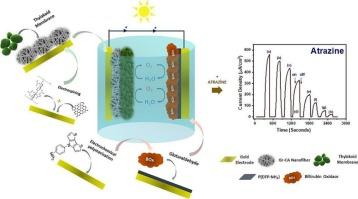利用类囊体膜和石墨烯-纤维素纳米复合材料制备的环境友好型生物光伏电池,用于太阳能收集和水基除草剂的光电化学监测
IF 4.7
3区 化学
Q2 CHEMISTRY, PHYSICAL
Journal of Photochemistry and Photobiology A-chemistry
Pub Date : 2025-09-17
DOI:10.1016/j.jphotochem.2025.116796
引用次数: 0
摘要
本研究探讨了生物光伏设备(bpv)作为全球能源和环境挑战的可持续解决方案的潜力。bpv利用叶绿素、绿藻和蓝藻等生物成分,通过光合作用将阳光转化为可再生能源。碳基电极,特别是石墨烯,由于其可负担性、优异的导电性和机械稳定性而受到关注。虽然还原氧化石墨烯通常被使用,但最近的研究强调了非氧化石墨烯优越的电流收集特性,值得进一步研究。此外,一维纳米材料,如静电纺纳米纤维,为提高电荷收集和电子转移效率提供了很好的机会。在这种情况下,设计了一种新的光阳极,集成了固定在石墨烯-醋酸纤维素静电纺纳米纤维基体上的类囊体膜,促进了有效的蓝藻粘附和电子转移。阴极采用电化学沉积镀有P(DTP-NH2)的金电极,随后用戊二醛活化胆红素氧化酶功能化。该系统的峰值功率密度为56.2 mW/m2,稳定电流密度为100 mA/m2。除发电外,BPV还具有除草剂生物传感能力,对阿特拉津的检测范围为0.1 ~ 1.2 μM,检测限为9.2 nM。回收研究证实了该系统作为生物传感器的可靠性,强调了其在可再生能源发电和环境监测方面的双重功能。本文章由计算机程序翻译,如有差异,请以英文原文为准。

Environmentally benign biophotovoltaic cell using thylakoid membrane and graphene–cellulose nanocomposite for solar energy harvesting and photoelectrochemical monitoring of waterborne herbicides
This study explores the potential of biophotovoltaic devices (BPVs) as sustainable solutions to global energy and environmental challenges. Utilizing biocomponents such as chlorophylls, green algae and cyanobacteria, BPVs convert sunlight into renewable energy via photosynthesis. Carbon-based electrodes, particularly graphene, have gained attention due to their affordability, superior electrical conductivity, and mechanical stability. While reduced graphene oxide is commonly employed, recent research highlights the superior current-harvesting properties of non-oxidized graphene, warranting further investigation. Additionally, one-dimensional nanomaterials like electrospun nanofibers present promising opportunities to enhance charge collection and electron transfer efficiency. In this context, a novel photoanode was designed, integrating thylakoid membranes immobilized on a graphene-cellulose acetate electrospun nanofiber matrix, fostering effective cyanobacterial adhesion and electron transfer. The cathode employed a gold electrode coated with P(DTP-NH2) via electrochemical deposition, subsequently functionalized with bilirubin oxidase using glutaraldehyde activation. The system achieved a peak power density of 56.2 mW/m2 and a stable current density of 100 mA/m2. Beyond electricity generation, the BPV demonstrated herbicide biosensing capabilities, detecting atrazine with a detection range of 0.1–1.2 μM and a detection limit of 9.2 nM. Recovery studies confirmed the system's reliability as a biosensor, underscoring its dual functionality in renewable energy generation and environmental monitoring.
求助全文
通过发布文献求助,成功后即可免费获取论文全文。
去求助
来源期刊
CiteScore
7.90
自引率
7.00%
发文量
580
审稿时长
48 days
期刊介绍:
JPPA publishes the results of fundamental studies on all aspects of chemical phenomena induced by interactions between light and molecules/matter of all kinds.
All systems capable of being described at the molecular or integrated multimolecular level are appropriate for the journal. This includes all molecular chemical species as well as biomolecular, supramolecular, polymer and other macromolecular systems, as well as solid state photochemistry. In addition, the journal publishes studies of semiconductor and other photoactive organic and inorganic materials, photocatalysis (organic, inorganic, supramolecular and superconductor).
The scope includes condensed and gas phase photochemistry, as well as synchrotron radiation chemistry. A broad range of processes and techniques in photochemistry are covered such as light induced energy, electron and proton transfer; nonlinear photochemical behavior; mechanistic investigation of photochemical reactions and identification of the products of photochemical reactions; quantum yield determinations and measurements of rate constants for primary and secondary photochemical processes; steady-state and time-resolved emission, ultrafast spectroscopic methods, single molecule spectroscopy, time resolved X-ray diffraction, luminescence microscopy, and scattering spectroscopy applied to photochemistry. Papers in emerging and applied areas such as luminescent sensors, electroluminescence, solar energy conversion, atmospheric photochemistry, environmental remediation, and related photocatalytic chemistry are also welcome.

 求助内容:
求助内容: 应助结果提醒方式:
应助结果提醒方式:


